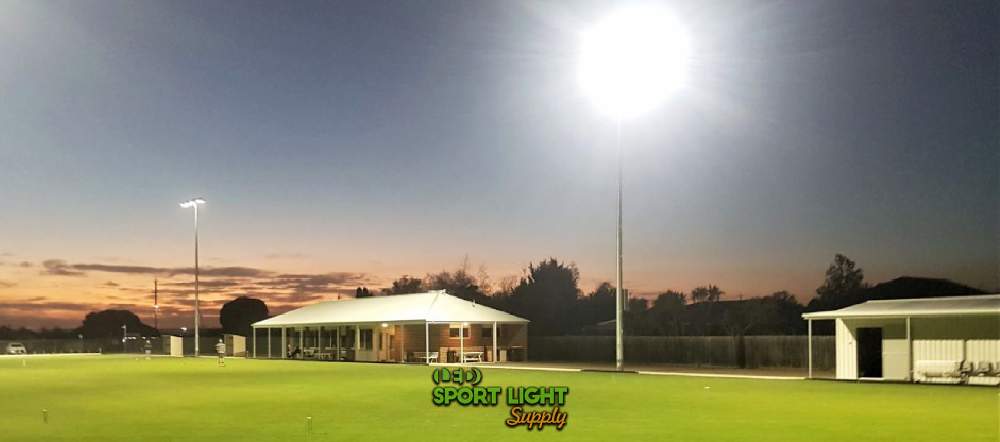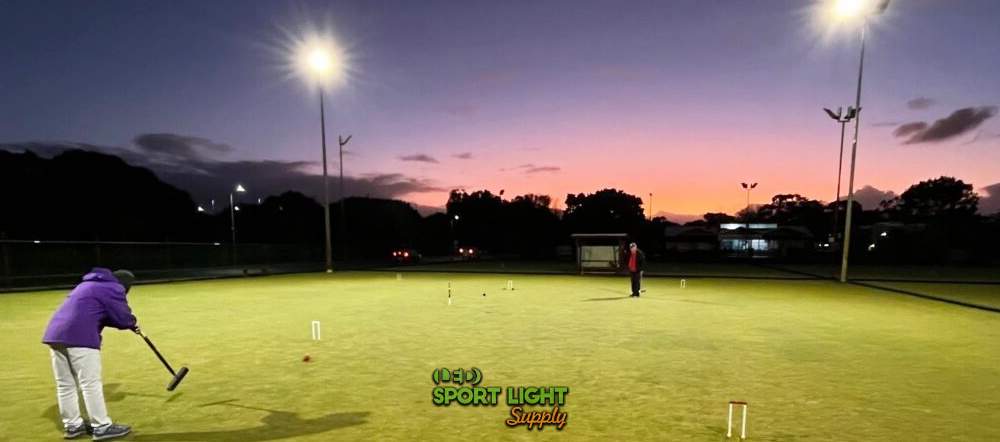Croquet, a sport renowned for its precision and strategic depth, demands a meticulously designed lighting system to uphold the game’s quality and improve the overall player experience.
Table of Contents
ToggleLED lighting has brought transformative advancements to croquet courts, setting new standards for illumination with its unparalleled clarity, energy efficiency, and durability. Traditional lighting solutions often fell short in delivering the level of brightness and uniformity needed for precision sports like croquet. LED technology, however, excels in these areas, providing crisp, bright light that enhances the visibility of the court and reduces the likelihood of glare, which can interfere with players’ focus and gameplay.
One of the most significant benefits of LED lighting is its ability to offer superior illumination with minimal distortion. In croquet, where every shot and strategic move relies on precise visual cues, maintaining a clear and consistent view of the court is crucial. LEDs ensure that the playing surface is evenly lit, eliminating shadows and bright spots that could disrupt the players’ concentration. The result is an enhanced playing experience where the quality of light directly supports the sport’s demand for accuracy and finesse.
In addition to their lighting performance, LEDs are highly energy-efficient compared to traditional incandescent or halogen bulbs. They convert a larger portion of energy into light rather than heat, which not only reduces energy consumption but also contributes to lower operational costs. This efficiency is particularly advantageous for croquet facilities that operate frequently or host evening matches, as it translates into significant savings on electricity bills. Moreover, LEDs have a longer operational lifespan, which means fewer replacements and less frequent maintenance, further driving down costs.
Beyond the financial benefits, LEDs are also environmentally friendly. Their reduced energy usage leads to a decrease in the carbon footprint of the facility, aligning with broader sustainability goals. By choosing LED lighting, croquet courts can enhance their environmental stewardship while benefiting from the high-quality illumination that the sport demands.
Switching to LED lighting is a strategic move for croquet courts, offering substantial financial benefits by significantly lowering both energy consumption and maintenance costs. Traditional lighting systems, such as incandescent and halogen bulbs, consume much more electricity to produce the same level of illumination as LEDs. This increased power usage results in higher utility bills, especially in facilities with extensive or continuous lighting needs.
LEDs, on the other hand, are known for their remarkable efficiency. They use a fraction of the power required by traditional bulbs, leading to considerable reductions in energy costs. This efficiency is particularly valuable for croquet courts that may be illuminated for extended periods, such as during evening matches or practice sessions. The lower energy consumption of LEDs directly translates into reduced electricity expenses, making them a cost-effective choice for facilities aiming to manage their operational budgets more effectively.
Moreover, LEDs have a significantly longer lifespan compared to traditional lighting options. While incandescent and halogen bulbs might need replacement every few months, LEDs can last for many years before needing to be replaced. This extended lifespan reduces the frequency of bulb changes and the associated labor and material costs. For croquet courts, this means less downtime and fewer disruptions to play, as well as lower maintenance expenses over time.

Achieving the right lux level is crucial for a well-lit croquet court. With a recommended range of 200 to 300 lux, players can enjoy clear visibility and precision without straining their eyes. Proper lux levels enhance gameplay by ensuring every detail of the court is visible, contributing to a fair and enjoyable experience.
Uniform illumination is essential for fair play on a croquet court. Uneven lighting can create distracting shadows and bright spots, impairing players’ vision and affecting their performance. By carefully planning light placement and using multiple fixtures, designers can achieve even light distribution, ensuring every part of the court is equally illuminated.
Effective light placement is crucial for optimal illumination on a croquet court. Positioning fixtures around the court’s perimeter, mounted on well-placed poles, ensures comprehensive coverage and minimizes shadows. Typically, four to six poles with strategically positioned lights provide the best results, ensuring the entire court is evenly lit.
The angle and direction of lighting play a critical role in the quality of illumination. For croquet courts, lights should be angled downward to minimize glare and ensure uniform coverage. Adjusting the angle to reduce reflections from the court’s surface is also essential, enhancing visibility and precision for players.

In the realm of croquet court lighting, the ability to customize lighting solutions is pivotal for enhancing both the aesthetic appeal and functional performance of the court. LEDs offer a range of customizable options that allow for tailored illumination to meet the specific needs of croquet courts, ensuring optimal lighting conditions for both players and spectators.
One of the key advantages of LED lighting is its flexibility in adjusting the light beam angles and intensity. Modern LED fixtures often come with adjustable optics, enabling precise control over the direction and spread of light. This feature allows lighting designers to strategically position lights to eliminate shadows and ensure uniform coverage across the entire playing surface. For croquet courts, where accurate and consistent illumination is crucial, this capability ensures that every part of the court is lit effectively, enhancing player visibility and performance.
Additionally, LED systems can be equipped with dimming features that allow for the adjustment of light intensity based on the time of day or specific requirements of the game. This flexibility is particularly useful for transitioning from daylight to evening play or for accommodating various weather conditions. By adjusting the brightness, facilities can maintain the ideal light levels for visibility and player comfort while also optimizing energy usage.
Color temperature customization is another important aspect of LED lighting. LEDs are available in various color temperatures, ranging from warm white to cool daylight. For croquet courts, selecting the appropriate color temperature can significantly impact the visibility of the ball and the clarity of court markings. Cooler temperatures (around 4000K to 5000K) are often preferred for outdoor sports as they provide a bright, daylight-like illumination that enhances contrast and sharpness, aiding in precise gameplay.
Integrating advanced control systems into croquet court lighting further enhances the flexibility and efficiency of the lighting setup. Smart lighting controls offer a range of features that improve the functionality and management of LED systems, making them a valuable addition to any modern croquet facility.
One of the primary benefits of smart lighting controls is the ability to schedule lighting operations. Facilities can program lights to automatically turn on and off at specific times, ensuring that the court is illuminated only when needed. This feature is particularly useful for managing energy consumption and reducing operational costs, as it prevents unnecessary use of lighting during daylight hours or when the court is not in use.
Dimming and scene-setting capabilities are also integral to advanced control systems. These systems allow for the adjustment of light levels based on various factors, such as the time of day, weather conditions, or specific event requirements. For example, lighting can be dimmed during practice sessions or adjusted to a higher intensity for evening matches, providing optimal illumination for different scenarios while conserving energy.
Additionally, some control systems offer remote access and management through mobile apps or centralized control panels. This functionality allows facility managers to monitor and adjust lighting settings from anywhere, providing convenience and enhancing operational efficiency. Remote control options also enable quick responses to any changes in lighting needs or issues that may arise, ensuring consistent and reliable illumination for every game.
Advanced control systems may also include features such as motion sensors and occupancy detection. These sensors can automatically adjust lighting based on the presence or absence of players, further optimizing energy use and enhancing safety. For example, lights can be set to turn on automatically when players enter the court and off when they leave, ensuring that the court is always properly lit when in use.
Maintaining a well-lit croquet court requires regular upkeep. Over time, light fixtures can become dirty or damaged, affecting their performance. Routine cleaning, inspections, and timely replacements of faulty components are crucial for keeping the lighting system in top condition and ensuring consistent playability.
Although LEDs have a longer lifespan compared to traditional lighting, they will eventually need replacement. Monitoring the performance of LED lights and replacing them before they dim significantly or fail entirely is essential. Regular system assessments help identify issues early, ensuring timely replacements and uninterrupted lighting quality.
Croquet courts are exposed to various weather conditions, making weather-resistant lighting a necessity. Selecting outdoor-rated LED fixtures that can withstand rain, wind, and temperature changes ensures reliable illumination year-round, regardless of the weather.
Designing croquet court lighting requires consideration of its impact on surrounding areas. Proper shielding and control of light spill help reduce light pollution and minimize disturbances to nearby residential areas. A well-designed lighting system balances bright, effective illumination with minimal environmental impact, fostering positive relations with the local community.
LED lighting has revolutionized the illumination of croquet courts, offering unparalleled benefits in clarity, efficiency, and sustainability. With the ability to provide precise, even lighting and customizable features such as adjustable beam angles, dimming capabilities, and color temperature options, LEDs enhance both the visual quality and performance of the game. Their energy efficiency and long lifespan not only reduce operational costs but also contribute to environmental sustainability. Integrating advanced control systems further optimizes lighting management, ensuring that croquet courts remain well-lit, cost-effective, and responsive to varying needs. Embracing LED technology represents a significant advancement for croquet facilities, delivering a superior playing experience while supporting broader goals of efficiency and ecological responsibility.
Drop us a line to receive a free lighting design